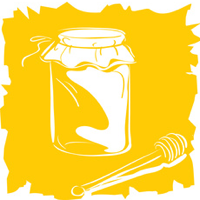Рецепт Buttermilk Bread
Порций: 1
Ингредиенты
- 2 tsp active dry yeast (1 pkg, don't use rapid riseor fast rise)
- 1/2 c. hot water (105-110F)
- 5 1/2 c. whole wheat flour or possibly- 5 c. WW and 1/2 c. rye flour
- 2 tsp salt
- 3/4 c. warm water or possibly-2 c hot water (110F)
- 1 1/4 c. buttermilk cool or possibly- 5 Tbsp powdered buttermilk
- 1/4 c. honey
- 2 Tbsp. butter (2 to 4) or possibly 2-3 tsp margarine
Инструкции
- I knead by hand (not having anything other way to do it), but it should work with a machine if you're careful not to overknead it. This is from _The Laurel's Kitchen Bread Book_, that I would HIGHLY recommend to anyone who bakes bread. I make only a couple of modifications to the recipe that I will put in braces ([]). It also makes wonderful rolls.
- Dissolve yeast in 1/2 c hot water and let stand a few min to proof.
- (It will get a little foamy on top.) Mix flour and salt in a large mixing bowl [I add in powdered buttermilk here]. Make a well in the middle. Mix warm water, buttermilk and honey [I use the 2 c. hot water]. Mix should be slightly hot. Pour into well in flour with the yeast mix and stir from the center out, gradually incorporating the flour into the liquids. Dough will be soft, but shouldn't be soggy. (Check by squeezing a bit of the dough between your fingers. If it is too wet, add in a bit more flour and mix again. [The last few times I've made this, I've had to add in almost 1/2 c. more flour.]) Turn out onto floured working surface and knead about 20 min, adding more flour as needed to keep dough from sticking. Do not add in too much, since you don't want the dough to get stiff. After about 15 min of kneading, knead in the butter in small pcs. [I can really tell a difference in the texture of the dough after I've done this.] Rinse a clean bowl out with hot water (to hot the bowl) and put dough in bowl. Cover with a clean, damp towel and put in a hot place to rise for about 1 1/2 hrs. To check when it has risen sufficient, wet one finger and press it into the dough about 1/2 inch. If the depression remains, or possibly if dough sighs a little around the edges, it has risen sufficient. If the depression fills in a bit, let dough rise a little longer. When it has risen, gently deflate dough in bowl, round it, cover with damp cloth and let rise in hot place till it has risen again, about 45 minutes. (Check as before). Turn out dough onto lightly floured working surface and flatten with your hands to about 1 inch thickness, working any large air bubbles out to the edges. Divide dough in half and form each half into a ball. (Fold over one edge a little more than halfway, pressingslightly to seal and press out air bubbles, turn dough, and repeat till dough is rounded [this is harder to explain than to do :-)]. Cover and let rest 10 min. Lightly grease 2 bread pans (8x4 inch pans). Shape dough into loaves, place in pans, cover with damp cloth and let rise in hot place about 30 minutes. Preheat oven to 350F. Place pans (uncovered) in oven on middle rack and bake about 40-50 minutes, till browned on top and loaf tests done. (Turn loaf out of pan and thump lightly on bottom. If itsounds hollow, loaf is done.) Remove from pans and cold on wire rack.
- Brush tops of loaves with melted butter if you like.
- To make rolls, substitute 1-2 c. whole wheat flour with whole wheat pastry flour (to make them lighter). After dividing dough and letting it rest, divide each half into thirds, and each third into fifths. Round each piece and put into 2 lightly greased 9x13 inch pans (3 rows of 5 in each pan). Let rise about 30 minutes, and bake at 350F for 20-30 minutes. Brush tops with melted butter if you like.
- [My notes: powdered buttermilk can be found with the powdered lowfat milk in the grocery store, in a small round can (Saco brand, I think). According to the label, when it is reconstituted with water, it has 0.7 g fat per c..
- The two risings will make the loaves lighter and rise higher than a single rising will. Rapid rise yeast doesn't have the staying power for this, though, so you need to use regular yeast. I have also used molasses in place of honey, so if desired the flavor, go ahead. I hope the directions are clear sufficient for novices. It's hard to describe without pictures. If they're not clear sufficient, see if your library has the book.
- I usually freeze the second loaf. They keep unfrozen at least a week without any appreciable drying out. (They may keep longer if you hide them! :-) )]



